There are an abundance of online meeting platforms available today. While some are designed for specific purposes like education, others are intended for communication which varies depending on the type of organization. When you peruse through all the online communication platforms, there is one attribute they all share, and that’s web video capabilities.
The Best Online Meeting Platforms
1. Zoom
Zoom is one of the most popular video conferencing solutions for businesses. It is feature-rich, with various plans based on business size and needs. Prices range from their free plan for personal and team meetings, to $19.99/month/host (with a minimum of 100 hosts) for large enterprises. Millions of worldwide Zoom users happily use the free plan, but if you are looking for something more encompassing for your remote teams, the enterprise-level plan includes up to 200 meeting participants, unlimited cloud storage, custom emails, a vanity meeting URL, and more.
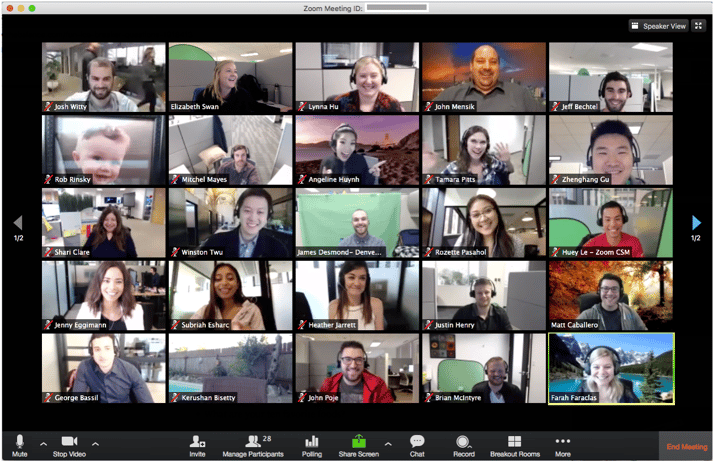
Source:Zoom
The Meeting Owl is now officially a Recommended Hardware Partner of Zoom. The Meeting Owl is Zoom’s only recommended 360-degree camera and features 1080p HD camera resolution, 360-degree visual and sound, and an 18-foot audio pickup radius. Try the Meeting Owl + Zoom today.
2. Skype for Business
Microsoft’s popular Skype service is augmented as an enterprise-ready video conferencing tool. It has several business features, such as allowing up to 250 attendees in a meeting, connection with other Skype users, and virtual whiteboarding capabilities.
While there are some limitations, such as the lack of an integrated dial-in audio conference feature, and lack of hardware support with online-only plans. The free version of Skype is a good tool for teams with less than 10 members, and is a simple way to make free conference calls from your computer, phone, or tablet.
 Source:Skype
Source:Skype
3. Slack
An extremely popular collaboration tool used in organizations all over the globe, Slack has integrated video conferencing features. If your organization is not using Slack, adopting it for video conferencing probably doesn’t make much sense. But, if you are already utilizing Slack, it is an easy way to make quick calls.
Video conferencing is an add-on to the functionality of Slack and can be a great tool for integrating hybrid teams. One-on-one video chat is part of Slack’s free account offerings and you can Slack with up to 15 people if you start a call from a channel, but for larger meetings, customized enterprise pricing is necessary, which requires a customizable quote.

Source:Slack
4. BigBlueButton
The open-source BigBlueButton features whiteboard capability for meeting productivity and was created specifically for education and online learning. As a free open source tool, there are many add-ons and integrations through third-party developers that allow for customized web conferencing experiences, including an integration with Learning Management Systems (LMS) that will make for a seamless student and teacher experience.
Some of the free features of BigBlueButton include:
- Audio and video screen sharing
- The option to record sessions for playback
- Breakout rooms
- Collaboration tools such as whiteboard, shared notes, and polling
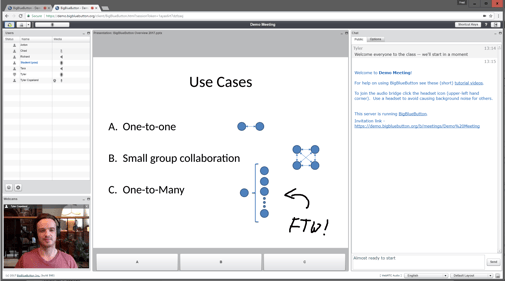
Source:BigBlueButton
5. BlueJeans
BlueJeans is a full-featured web conferencing app that integrates with collaboration tools. Touting a simple and modern approach, in contrast to some of the more complex services offered by competitors, Bluejeans uses a system of meetings, rooms and events to enable video meetings anywhere.
No software is required with the ability to launch meetings from a browser. Also, the service allows for easy viewing of all video conference activity in your organization. Plans start at $16.65/month/host for enterprise teams.

Source:BlueJeans
6. Whereby
This video chat service is ideal for small organizations that want a simple method for connecting team members. It features a fast service due to its streamlined nature.Whereby (formerly Appear.in) doesn’t require an app download or login, users simply share their meeting link and anyone can join in-browser. Whereby starts free, but teams will want to pay $59.99/month, which will allow multiple users and admins.
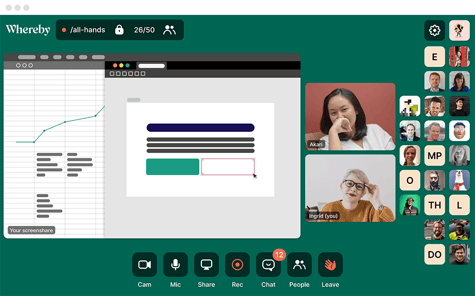 Source:Whereby
Source:Whereby
7. GoToMeeting
GoToMeeting pricing starts at $14/month for groups of up to 10 meeting participants, and costs $29/month for larger groups of 150 participants.
This teleconference tool is worth the cost, which includes features such as:
- Screen sharing on desktops, tablet, or smartphone
- HD video conferencing
- The Smart Meeting Assistant that allows you to record meeting and generates an automated transcription
- A hardware bundle kit with user-friendly video conferencing software
- Business messaging that can transition from a chat box to a video call with the click of a button
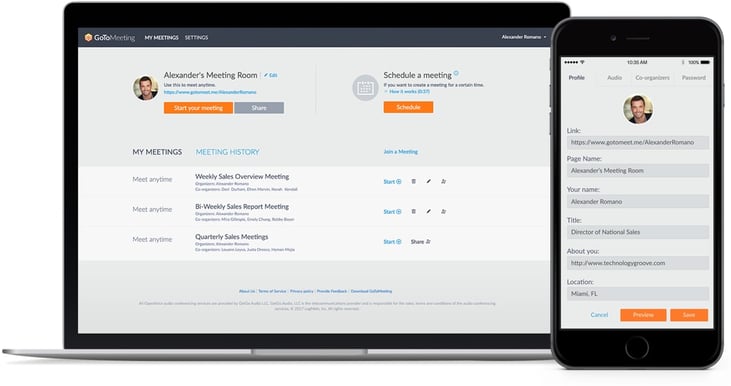 Source:GoToMeeting
Source:GoToMeeting
8. Cisco WebEx
An industry-standard service, especially for those with a large number of team members or an exceptionally large enterprise, Cisco’s WebEx video conferencing service operates like a mash-up of web conferencing and voice calling services, as it enables joining meetings online or via the phone, depending on the participant’s location and ability at the time. Pricing starts at $13.50/host/month.
 Source: Cisco WebEx
Source: Cisco WebEx
9. Google Meet
Created for enterprise customers, the Google conference call software is Google Meet. It’s an upgraded version of Google Hangouts made for teams. Google Meet is designed around scheduled video meetings among team members, with similar features to Zoom like calendar syncing, conference room booking, and a more polished user interface.
To reap all the benefits Google Meet has to offer— unlimited meetings up to 300 hours long, 250 attendees, the ability to live-stream to up to 100,000 viewers, and 24/7 online support among others— you’ll want to contact the G Suite sales team for your personal quote.
 Source:Google Cloud
Source:Google Cloud
10. Blackboard Collaborate
Blackboard Collaborate is the video conferencing app of choice for educators. With mobile accessibility, this tool helps educators connect with students on laptops, tablets, or smartphones. Classroom licenses start at $300/year, departments at $9,000/year for universities, schools, and colleges, and enterprise options are available at custom pricing.
GoToMeeting (iOS, Android, macOS, Windows, Web for participants)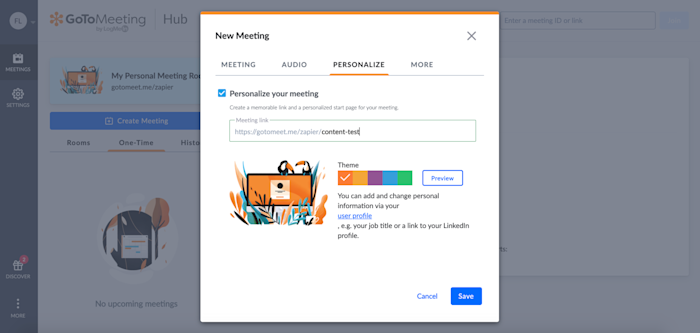
GoToMeeting is part of LogMeIn’s family of video conferencing apps that let you meet with your team or broadcast a webinar to thousands of viewers. With GoToMeeting, you’ll schedule meetings online, then use GoToMeeting’s app to join calls, share your screen, and present to audiences.
You can choose to schedule a recurring session or start a one-time call. And GoToMeeting also lets you create a custom link for your meeting—which is a great feature if you’ll be inviting people outside your organization or running a publicly-available virtual event like a webinar.
GoToMeeting offers all the features you’d expect from a video conferencing tool aimed at professionals, including call recording, dial-in numbers (or an option to have GoToMeeting call your number so all you have to do is answer), and HD video for up to six participants. You can even monitor your audio levels from the app’s toolbar, so you can see exactly how loud you’re being during the call.
The downside is that the app can be a little confusing due to all the features and options available. For the most part, though, GoToMeeting is a reliable option that can be a good choice if you want a tool for team calls and webinars.
You can use Zapier to connect GoToMeeting with your other favorite apps and automate away some meeting-related work. Some common GoToMeeting automations include automatically creating meetings for new calendar events or when someone books an appointment in your scheduling app.
Google Meet
Google has so many different apps and solutions — like Google Voice for a free phone number — that it can be really difficult to keep track of everything they offer. While Google Voice and Google Meet do have integrations for one another, Meet can do much more than just basic calling options Google Voice offers. Of course, just like most other Google apps, Meet is completely free. Users can send/receive instant messages, video chat, send/receive SMS messages, and host VoIP calls. Furthermore, Google Meet also supports captioning in German, Portuguese, French, English, and Spanish (Spain as well as Mexico) ensuring that your team members can communicate efficiently regardless of where they’re from.

What many often overlook, is the ability to screen share baked right into Google Meet on top of everything else the app offers. Google has actually stated that it plans for Google Meet to be the future of its telephony product, so of course, that’s where all the great features are. The free web conferencing that Google Meet provides is also extremely accessible since anyone with a Gmail account can be invited in just a couple of clicks. All meetings also automatically sync with your Google Calendar to ensure you never forget about a video conference even on your busiest day.
Conclusion
Whether you are a business owner or an employee, chances are that you work in an environment where you share and exchange information and data with your co-workers and clients/customers. More often than not, this information and data is sent through emails or exchanged through phone calls. But the fact remains that using email and calling each other for sharing and exchanging information is not the most efficient way to get things done.
